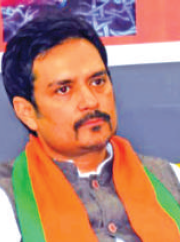The Unfinished Dream of Lt. Shyama Prasad Mukherjee: Kashmir’s Full Integration with India

Abhijeet Jasrotia
On August 5th, 2023, as chants of “Joh Kashmir Humara Hai Woh Sare Ka Sara Hai” echoed from the banks of Dal Lake, discomfort rippled through Pakistan’s ISI and certain elements within India. However, the undeniable truth remains that the ultimate tribute to the profound sacrifice of Lt. Shyama Prasad Mukherjee can only be realized when the entirety of Kashmir becomes an integral part of Bharat (India). This vision remains incomplete without a well-defined time frame for its realization, and it is the central leadership’s prerogative to bring this aspiration to fruition, given their intent, determination, and capability.
A Possible Path Forward:
The formula for achieving this integration must extend across the border, involving a careful examination of historical records. Report No. 183 from the Parliament of India’s Rajya Sabha, dated December 22nd, 2014, officially acknowledges the displaced persons of 1947 and mentions the de-freezing of 8 seats for PoJK DP (Pakistan-Occupied Jammu and Kashmir Displaced Persons). The government can now press for the de-freezing of all remaining seats in PoJK and simultaneously conduct elections throughout Jammu and Kashmir, including PoJK. To ensure a fair electoral process, candidates can participate from across the border, and voting can be conducted through postal ballots, with the count taking place in India. This approach should face little resistance from political parties in Kashmir, given that the people on the other side share a common bond and have suffered due to the oppressive actions of the Pakistan Army and ISI.
Legal Grounds and International Claims:
India’s claims over PoJK are well-founded in the Instrument of Accession, signed by Maharaja Hari Singh, which unequivocally states the entire Jammu and Kashmir’s merger with India. This historic document, kept in the Amritsar court, highlights the Maharaja’s dominion extending up to Tibet and encompassing the whole of PoJK. Thus, our claim over PoJK and Tibet remains indisputable.
The illegal occupation of Tibet by China has led to the Tibetan diaspora, and their claims for justice can be aligned with India’s. The illegal China-Pakistan Economic Corridor (CPEC) in PoJK is also built on land owned by people currently residing in India, primarily in Jammu and Kashmir and Himachal Pradesh (Kangra). These original landowners possess legal documentation to substantiate their claims.
A Path to Justice:
The illegal occupations of both Pakistan and China can be challenged effectively through these documents, especially since the rightful landowners are still living, either under occupation or in exile. India, driven by the principle of “Vasudhaiva Kutumbakam” (the world is one family), assumes the responsibility to deliver justice to these oppressed regions.
The unfinished dream of Lt. Shyama Prasad Mukherjee, encapsulated in “Jis Kashmir Ko Khoon Se Seencha Woh Kashmir Humara Hai” (The Kashmir we have irrigated with our blood belongs to us), beckons us to fulfil this unaccomplished goal. With legal evidence and global support, there is hope that the dream of a fully integrated Kashmir can be realized, not only for India but for all those who believe in justice and freedom.
(The author is J&K BJP Spokesperson and can be reached at [email protected]).
